Words of Wisdom - Shastra
& Shastrakaras speak
For Books and shastra downloads see Main Index, under
Books:
Om Namo Bhagavate Vasudevaya
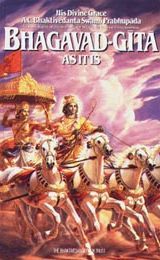
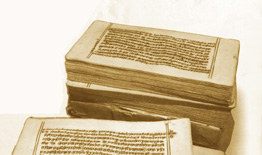
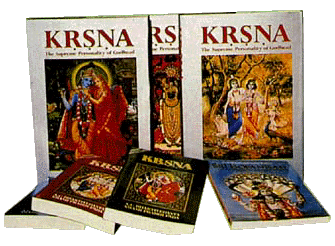
The Complete Works of Srila Prabhupada
All the books, the letters and conversations at your
fingertips
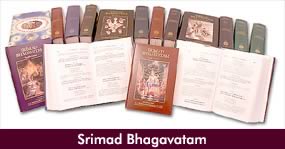

All Srila Prabhupada's books and more on one disk
http://www.vedabase.com




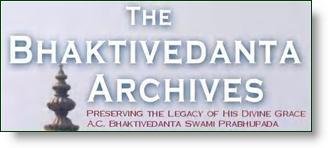
Srila Prabhupada's Audio lectures to listen to on-line:
http://www.hare-krishna.org/srila-prabhupada-lectures.htm
Listen to Srila A.C. Bhaktivedanta Swami Prabhupada on-line
- all 900 of his lectures are available HERE:
http://www.prabhupadavani.org/
Srimad Bhagavatam - the entire lecture series listen and
read along on-line - Narrated by Amala Bhakta dasa:
http://www.prabhupadavani.org/SB_index.html
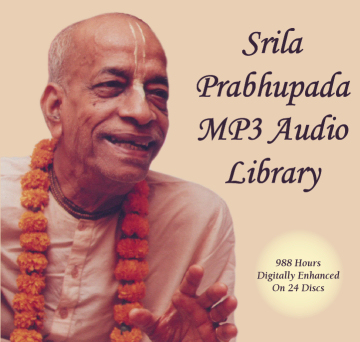
The new enhanced Prabhupada MP3 series
http://www.prabhupada.com/store/store.php?page=product.php&id=MP3AUDIOLIB








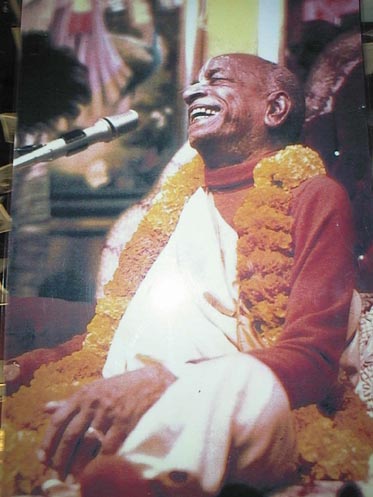
Visit "Prabhupada Connect" for all manner of Prabhupad
Nectar:
http://www.prabhupadaconnect.com/Index.html
Srila Prabhupada's Final Lesson Video - Downloadable and
viewing on-line
http://users.iskconludhiana.com/images/thumbnails.php?album=21


All Srila Prabhupada's original books
available for sale here.

Download all the Hare Krsna teachings which includes
all Vaisnava and
Vedic concepts by visiting one of the sites listed at
the following address.
http://www.geocities.com/suci123/bookdownloadsites1.html
The Bhaktivedanta Book Trust
Srila Prabhupad Memorial Library
http://www.krishna.com/main.php?id=33


33 Books Online Including Srimad Bhagavatam!
http://www.geocities.com/freeprabhupadabooks
The compressed "self extracting" file mentioned is now currently
available for download
http://www.krsnaconsciousness.org/Gauranga/Folio/BhaktivedantaVedabase_DOS.exe

Download or Listen to Prabhupad Bhajans HERE:
http://www.prabhupadavani.org/web/text/Bhajans.html


On-line 1972 McMillan edition - Bhagavad Gita As It Is:
http://www.asitis.com/

Bhagavad Gita AS IT IS on-line through the Tirupathi
Balaji site:
http://www.bhagavad-gita.us/

Bhagavad Gita Study guide on-line book:
http://chantandbehappy.com/gita/studyguide/StudyGuide-main.htm
Bhagavad Gita Study guides by numerous Iskcon devotees
- FREE downloads:
http://www.veda.harekrsna.cz/library/#3

All the Scriptures you'd ever need 4 FREE
http://www.hknet.org.nz/index-books.htm
http://www.hknet.org.nz/DDB.htm
http://www.hknet.org.nz/DDB2.html
last updated 4th August 2003


Srimad Bhagavad Gita AS
IT IS
Bhagavad Gita: Chapter
6 - Dhyana-yoga
TEXT 16
naty-asnatas tu yogo 'sti
na caikantam anasnatah
na cati-svapna-silasya
jagrato naiva carjuna
WORD FOR WORD
na--never; ati--too much; asnatah--of one who eats; tu--but;
yogah--linking with the Supreme; asti--there is; na--nor; ca--also; ekantam--overly;
anasnatah--abstaining from eating; na--nor; ca--also; ati--too much; svapna-silasya--of
one who sleeps; jagratah--or one who keeps night watch too much; na--not;
eva--ever; ca--and; arjuna--O Arjuna.
TRANSLATION
There is no possibility of one's becoming a yogi, O Arjuna,
if one eats too much or eats too little, sleeps too much or does not sleep
enough.
PURPORT by HDG Srila A.C. Bhaktivedanta Swami Prabhupad:
Regulation of diet and sleep is recommended herein for
the yogis. Too much eating means eating more than is required to keep the
body and soul together. There is no need for men to eat animals, because
there is an ample supply of grains, vegetables, fruits and milk. Such simple
foodstuff is considered to be in the mode of goodness according to the
Bhagavad-gita. Animal food is for those in the mode of ignorance. Therefore,
those who indulge in animal food, drinking, smoking and eating food which
is not first offered to Krsna will suffer sinful reactions because of eating
only polluted things. Bhunjate te tv agham papa ye pacanty atma-karanat.
Anyone who eats for sense pleasure, or cooks for himself, not offering
his food to Krsna, eats only sin. One who eats sin and eats more than is
allotted to him cannot execute perfect yoga. It is best that one eat only
the remnants of foodstuff offered to Krsna. A person in Krsna consciousness
does not eat anything which is not first offered to Krsna. Therefore, only
the Krsna conscious person can attain perfection in yoga practice. Nor
can one who artificially abstains from eating, manufacturing his own personal
process of fasting, practice yoga. The Krsna conscious person observes
fasting as it is recommended in the scriptures. He does not fast or eat
more than is required, and he is thus competent to perform yoga practice.
One who eats more than required will dream very much while sleeping, and
he must consequently sleep more than is required. One should not sleep
more than six hours daily. One who sleeps more than six hours out of twenty-four
is certainly influenced by the mode of ignorance. A person in the mode
of ignorance is lazy and prone to sleep a great deal. Such a person cannot
perform yoga.
His Divine Grace A.C. Bhaktivedanta Swami Prabhupada
Copyright 1983 The Bhaktivedanta Book Trust International. Used with
permission.

Bhagavad Gita As It Is - http://www.asitis.com/
Bhaktivedanta Vedabase - Bhagavad Gita on-line http://bhagavadgitaasitis.com/
Bhaktivedanta VedaBase: Bhagavad-gita As It Is http://vedabase.net/bg/en
Bhagavad Gita Multi Media Web-version http://chantandbehappy.com/gita/
Listen to Bhagavad Gita on line - http://www.Gitamrta.org
View our Bhagavad Gita Overview:
http://www.hknet.org.nz/BG.html
Archive: http://www.cs.rice.edu/~vivek/btg/archive/
Home Page: http://www.cs.rice.edu/~vivek/btg/
Join Bhagavad Gita eGroups HERE
mailto:bhagavad_gita-owner@egroups.com


Prabhupada Uvacha:
(here's some nectar, sometimes it comes in the form of Srutakirti prabhu's
diary, other times from Govinda dasi's diary, Hari Sauri prabhu's Transcendental
Diary, Bhurijan prabhu's book, or sometimes from a letter, or other related
source, but still nectar...)
May 1st, 1976
There are not many engagements or visitors, so
Srila Prabhupada often calls in the sannyasis or whoever else is around
to discuss Krsna conscious philosophy with them. Always enlivened to preach
and to encourage his disciples to preach, he needs no prompting to speak.
He simply rings his bell, and when someone comes he sits them down and
begins to speak on the Bhagavad-gita. His favorite topics are modern science
and all pseudospiritual cheating processes. He has us look up various verses
in the Gita and read them out, often along with his purports, and then
he elaborates the philosophical points by relating them to practical examples.
Prabhupada doesn't just know the highest philosophical concepts, he knows
the application, and this is what makes him such an effective preacher.
He convinces us because he relates everything to situations within our
daily experience.
Discussing the position of the soul within the
body, he had Gurukrpa Maharaja read out verse seven from Chapter Fifteen:
"The living entities in this conditional world are My eternal, fragmental
parts. Due to conditioned life, they are struggling very hard with the
six senses, which include the mind."
He gave a simple, effective comparison: "So with
this instrument he's manipulating this machine; as exactly the pilot, with
so many electronics, machine, he's working the flying of the plane. Where
is the difficulty to understand? This body is a machine. Bhramayan sarva-bhutani.
The aeroplane is wandering; this machine is wandering. Urdhvam gacchanti
sattva-sthah. Sometimes up, sometimes down. Find out this." Gurukrpa flicked
through the pages of the Gita as Srila Prabhupada continued with a demonstration
of his example. "Same aeroplane, going up and down. Two wings, this hand,
like this."
Gurukrpa read out the verse: "Those situated in
the mode of goodness gradually go upward to the higher planets; those in
the mode of passion live on the earthly planets; and those in the mode
of ignorance go down to the hellish worlds." (Bg. 14.18)
"So the same thing," Srila Prabhupada explained.
"If the pilot is not expert, then goes down to the lowest, finished. Adho
gacchanti tamasah. If the pilot is third class, instead of going up, he
goes down, and everything is spoiled. So everything on the pilot; the machine
is not important. The machine can go up if the pilot knows how to do it.
And the machine can go down. Actually, it is happening. This landing point
is very dangerous. If the pilot cannot handle very nicely, immediately
smashed. All crises take place while coming down and going up. I have seen
sometimes, they clap as soon as they ... " Prabhupada clapped his hands,
grinning and raising his eyebrows as if in relief, making us all laugh.
"'Oh, the danger is over!'
"In this way," he said, "you have to place the
subject matter, that the living entity, the soul, is the important thing
within this body. On account of his ignorance, he's struggling. Manah sasthanindriyani
prakrti-sthani karsati. This is his position."
He said since the body is temporary and must die
one way or the other, learned persons do not lament over it. But still
he said there was something to lament.
"So what is to lament after this body? Lamentation
is that the person within the body, whether he's going to hell or heaven.
Urdhvam gacchanti or tamo gacchanti. That is real concern. Body will be
finished, today or tomorrow or after a hundred years. Who can protect it?
But one should be interested with the owner of the body, where he is going,
what is his next position. There are three status: up, down, and the same."
- From the "A Transcendental Diary Vol 2" by HG
Hari Sauri dasa
To receive little snippets of nectar like this on a daily basis subscribe
HERE: or If you want to introduce anyone else in reading Srila Prabhupada
Nectars, please send their eMail addresses to mailto:krpamaya_gauranga@hotmail.com
Please Chant:
 Hare
Krishna Hare Krishna Krishna Krishna Hare Hare
Hare
Krishna Hare Krishna Krishna Krishna Hare Hare
 Hare
Rama Hare Rama Rama Rama Hare Hare
Hare
Rama Hare Rama Rama Rama Hare Hare
...................and be Happy

Listen to Srila Prabhupad on-line
....a different lecture, morning walk, conversation or
class daily.
"Chemicals Come From Life"
>>> Ref. VedaBase => 74/02/19 Bombay, Bhagavad-gita 7.4
Listen to the entire lecture on-line:
http://prabhupadaradio.com/M3U/Gita/m3u/GT224.m3u
Pradyumna: ...fire.
Prabhupada: Is it ?
Devotee: No.
Pradyumna: "Vayuh... (leads chanting, etc.) Translation:
"Earth, water, fire, air, ether, mind, intelligence and false ego -- altogether
these eight comprise My separated material energies."
Prabhupada:
bhumir apo 'nalo vayuh
kham mano buddhir eva ca
ahankara itiyam me
bhinna prakrtir astadha
Prakrti means energy. So, because we are in the material
world, our material science is simply studying the material energy of Krsna.
Physical, chemical, light, sound, these are the subject matter of the scientists
to understand. But they do not know wherefrom these material elements come.
In the Srimad-Bhagavatam or in the Vedic literature it
is said that the material energy came out of the breathing of the Supreme
Lord, Maha-Visnu.
yasyaika-nisvasita-kalam athavalambya
jivanti loma-vilaja jagad-anda-nathah
visnur-mahan sa iha yasya kala-viseso
govindam adi-purusam tam aham bhajami
[Bs. 5.48]
The material energy is coming through the breathing of
Maha-Visnu, who is lying down in the Karana, Causal Ocean. So, from the
breathing there is sound. From the ether, the sound comes -- this is scientific
-- and from the sound, the air comes, the fire comes, then water comes,
then the earth comes. The earth is the last, gross element in the material
science. Therefore Krsna says this earth, bhumi... Bhumi, earth, has come
out of water, apah. And wherefrom apah, water, has come? Analah, fire.
Wherefrom fire has come? From air. Where the air has come? Ether, sky.
Wherefrom the ether has come? False ego. Where from it has come? Mind.
Wherefrom it has come? Intelligence. And wherefrom it has come? From the
soul. This is the scientific study. But they do not know background of
the soul. They're thinking, "There was a chunk and there was something.
That's all. Perhaps, it may be." No definite knowledge. But here you can
take the definite knowledge, wherefrom these material elements come. This
Krsna is the Supreme Soul.
So from the Supreme Soul all these material elements have
come. Just like your body. Wherefrom it has come? It has come from the
soul. In the sastra it is said, karmana daiva-netrena jantur deha-upapatti
[SB 3.31.1]. Jantu. Jantu means living entity, jan word(?), jantu. So jantur
deha-upapatti. There... The atheist theory that combination of matter makes
a situation when living symptoms come out, combination of matter, that
is the present chemical theory, chemical evolution. There are so many theories
based on Darwin's theory, chemical evolution. Recently, when I was in Los
Angeles, one German scientist came there. He has written one book, Chemical
Evolution, and he has got Nobel Prize. Now he's touring for lecturing on
his theory. So in the California university there is our student, Dr. Svarupa
Damodara. He's my disciple. He's doctor in chemistry. So, when this German
chemist was lecturing, theorizing that life has come from chemicals, so
he put the question that "Suppose if I give you these chemicals, whether
you can prepare a life?" He answered in the meeting, "That I cannot say."
That means he's not certain; still, he's theorizing, that from chemical,
life has come. No, from chemical, life has not come; from life, chemical
has come. This is real theory.
So these things are discussed very broadly in our American
centers, so we stick to the point that life does not come from chemical,
but chemical comes from life. So I gave one crude example. Just like a
tree. It is also life, because there are different forms of life, 8,400,000
forms of life. So a tree also, another form of life. One who knows what
is the condition of life, pandita, learned, sama-darsinah.
vidya-vinaya-sampanne
brahmane gavi hastini
suni caiva sva-pake ca
panditah sama-darsinah
[Bg. 5.18]
Pandita, who knows what is what, he is sama-darsi, equipoised.
He knows that the substance within the tree or substance with the dog or
substance with the human being or substance within the brahmana or a sudra
or a dog or a candala -- the soul is the same. Therefore, he sees everyone,
sama-darsinah. Panditah sama-darsinah [Bg. 5.18]. He does not distinguish
between man and animal or tree. Because he knows that the living force
is the same, spiritual quality that is the fragmental portion of the supreme
soul, Krsna. So we can understand, if we are little sober, how material
things come out.
continued.......................
Listen to the entire lecture on-line:
http://prabhupadaradio.com/M3U/Gita/m3u/GT224.m3u
or receive in mailbox and Subscribe HERE:
mailto:lectures-subscribe@prabhupadavani.org
Sravanam kirtanam at:
http://www.PrabhupadaVani.org
© 2001 The Bhaktivedanta Book Trust International. Used with permission.

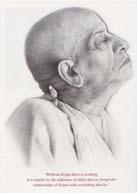
SRILA PRABHUPADA'S QUOTE OF THE DAY
The more you serve, the more you relish taste.
Without relishing taste, nobody can render devotional service. It is practical.
The Nectar of Devotion,
Vrndavana 1972
Sign-up to receive these quote HERE:
mailto:haribol@pacific.net.sg

Bhaktivedanta Vedabase Network ...
http://vedabase.net/


The Scientific - Mathematical
Proof for God's existence:
http://geocities.com/sector114
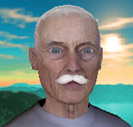
http://robot-hosting.com/php/login_nicholas.html
user name = guest
password = guest
(Collection of philosophical and mathematical proofs
for existence of God can be found in this site.)

Scientifically Philosophical Books for the layman
 ...
...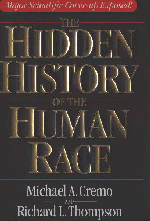 ...
...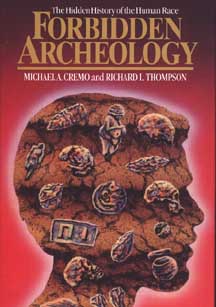 ...
...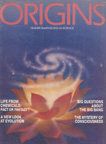
Click on any of these books to read more about them and where to get
a copy
or contact your local temple for purchases
sample of Life
comes from Life HERE.pdf

Lotus Imprints - Preserving Prabhupada's Legacy - The
Publishing House of Hari Sauri dasa
http://www.lotusimprints.com/

Quotes from Shastra - scriptures
View using Balaram font
 Srila
Advaita Acharya - Shantipur, West Bengal
Srila
Advaita Acharya - Shantipur, West Bengal
The following is from Shaligram Tirtha
Pradarshini
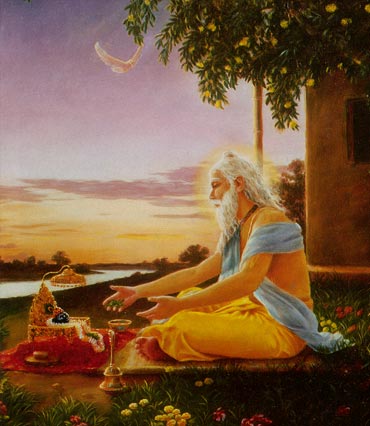
Haribol Prabhus,
There are two temples in Shantipur. One is in the village where ISKCON
participates in the Shantipur festival on the disappearance day of Madhavendrapuri.
And, the other temple is in the city. These pictures were taken the next
morning in Shantipur after the festival.


Shantipur City temple  Shantipur
village temple
Shantipur
village temple
While attending the festival 2005, we inquired about the Saligram Sila
that Sri Advaita Acarya worshiped to call Lord Caitanya. The priest, a
descendant of Advaita Acharya, said that the saligram was buried under
the altar 200 years ago for it's protection. I didn't believe the story
so I returned the next morning after mangal arati with His Holiness Amilavilas
Swami. He spoke with a different pujari who agreed to bring the saligram
silas out for us to see. They are not on the altar for darshan normally.
The picture with the two nrsmhadeva silas and three others are from the
temple in the village. The pujari said that one of the two nrsmha silas
has responsible for the descent of Lord Caitanya. The pujari gave us the
tulasi leaves from the saligrams as prasadam. We honored some of them,
and I took one home and put it on my altar. I also had brought my Bala
Gopal sila and the purjari bath him along with the nrsmha silas.

Advaita bhavan Shantipur village temple Salagram silas

We also visited the Advaita temple in the city. Amazingly, the pujari
there looks just like the pujari in the village. Of course, he is a descendant
of Sri Advaita also. He showed us another nrsmha sila that Sri Advaita
worshiped also. So, one of the three is the one. Or, maybe he is buried
under the altar like the first pujari said.

Sri Nrsimhadev from the City temple
The village temple is were Lord Caitanya, Lord Nityananda, and Sri Advaita
would meet to discuss how to spread the sankirtan movement. Srila Prabhupada
would visit this temple during his grhastra days and later as a sannyasi
and pray for the blessing to spread the sankirtan movement in the west.
So, this is a very powerful and Krsna Conscious location. I'll tell that
story at the end of this article.
An interesting point I like to make is that this Nrsmha Sila actually
brought Radha and Krsna together as Sri Caitanya Mahaprabhu. This Sila
gave birth to the Sankirtan movement that we all are participating in today.
Sri Advaita Acharya offered tulasi and ganges water and begged for the
appearance of the Lord to the Nrsmha sila. That sila fullfilled the request
and cause the descent of Mahaprabhu. That is a very special saligram. I
offered my obeisances and beg for empowerment to spread Krsna Consciousness
in the west from that Saligram. I prayed at both temples.
I hope some others can shed more light on the history of this saligram.
The pujari in the city said that an ISKCON matajai spent a few months there
compiling a research paper for her Doctorate in Religion in 2002 or so.
He showed us the book but we didn't have time to read much. I only had
a short time to visit Mayapur this year (2005) and could not return to
discuss more with the pujaris.
Srila Prabhupada and Advaita Bhavan
Sri Advaita Acarya's house is very significant also because Srila Prabhupada
visited there often to beg for empowerment to spread Krsna Consciousness
in the west. In 1980 at our Caitanya Candrodoya Mandira in Mayapur, the
pujari of the temple visited and told the story of Srila Prabupada's visits.
This pastime was told at the Sanitpur festival this year and is also in
the book "Our Srila Prabhupada a Friend to All". It is compiled by the
late Mulaprakrti devi
dasi ACBSP. It is a collection of interviews with people outside of
ISKCON who new Srila Prabhupada before and after he began preaching in
the west. The pastime is as follows.
During the 1940's and 50's, the pujari noticed that one grhastha Bengali
devotee used to come to the temple quite regularly. He was dressed in a
white khadi dhoti and kurta and he always came alone. He would sit in the
back of the mandira without speaking, and he would chant hari-nama on his
mala very quietly and deeply. He would come on weekends, usually once every
month or two. After chanting there for many hours, he would always thank
the pujari and leave. Since his devotion was solitary, the pujari never
disturbed him. The pujari would notice that while he chanted, his eyes
would be full of tears and his voice would choke up.
Then for a long time, he did not come back. However, the pujari remembers
that in August of 1965, he saw a saffron-clothed sannyasi sitting in the
back of the mandira. He recognozied him to be the person from before. Again
he sat for a long time chanting Hare Krsna. He was weeping unabashedly
even more than before while he took the Holy Name. Finally, as evening
came, he paid his dandavat pranama for a long time. When he arose, he came
up to the pujari and thanked him for his seva at Advaita Bhavan. The pujari
asked him, "Who are you? I remember you from so long ago." He replied,
"My name is Abhaya Caranaravinda Bhaktivedanta Swami Maharaja. I am an
unworthy disciple of His Divine Grace Srila Bhaktisiddhanta Sarasvati Thakur,
Srila Prabhupada, my divine master. I have been coming here for such a
long time becasue my gurudeva has given me an impossible mission. His desire
was for me to go across the ocean to the Western countries and spread the
sublime teaching of Sri Caitanya Mahaprabhu. I have not known how this
mission of his will be successful, so I have been coming here to this special
house of Advaita Acarya, where he, Nityananda Prabhu, and Sri Caitanya
Mahaprabhu would gather to plan the sankirtana movement. It was here that
they launched the inundation of love of God that swept India and continues
to this day. Thus, I have been praying very earnestly here that they will
all give me their mercy and somehow they will empower me and guide me.
I want to satisfy my gurudeva's desire, but I am feeling unqualified to
do this."
As he was speaking to the pujari, he saw tears falling down on his cheeks
again. Then he continued, "Tomorrow I am leaving for Calcutta to go upon
a ship across the ocean to America. I do not know what will befall me there,
but I am praying most earnestly here for help." Then, he very humbly asked
the pujari for his blessings.
It was a few year later that the pujari began to noticed, for the first
time, white Vaisnavas coming to Advaita Bhavan. They were wearing dhotis
and saris and chanting on tulasi-mala. The pujari never spoke to any of
them but then one of them gave him a "Back to Godhead" magazine from America.
As the pujari was looking through it, he saw a painting of Srila Prabhupada
label as the Founder-Archaya who brought Krsna Consciousness to the West.
It was a picture of his old friend, Bhaktivedanta Swami, who had come and
prayed there so many times before. He then realized that he had actually
accomplished that impossible mission of his gurudeva. He saw that it was
indeed he, starting alone and without pretense, who had accomplished this
glorious miracle against all odds. As soon as the pujari saw this, he came
to the temple in Mayapura to tell this information.
Jagaguru Srila Prabhupada KI JAYA!!!!
ys,
Sikhi Mahiti das ACBSP

Shantipur City temple

HH Amilavilas swami watching a monkey in the court yard of the temple

The pujari of the Shantipur City temple

The pujari of the Shantipur village temple talking with HH Amilavilas
swami

Shantipur village silas

The Tablet glorifying Sebayet is from the country (village) temple also.


The following Sections are from Sri Gaudiya Kantahara
Impersonalist Sannyäsés
are Condemned
15.44
sannyäsé haiyä
niravadhi "näräyaëa"
baliveka prema-bhakti-yoge anukñaëa
nä bujhiyä çaìkaräcäryera
abhipräya
bhakti chäòi mäthä
muòhäiyä duùkha päya
Sannyäsés always
say the name of Näräyaëa and worship him in prema-bhakti-yoga.
Not understanding the position of Näräyaëa, the followers
of Çaìkaräcärya give up the path of bhakti; such
fools attain only trouble and misery. (Cb. Antya 3.54,55)
Only Unmotivated Devotional Service
Gives
Complete Satisfaction to the Soul
15.45
sa vai puàsäà
paro dharmo yato bhaktir adhokñaje
ahaituky apratihatä yayätmä
suprasédati
The supreme dharma for all
humanity is that by which men can attain to loving devotional service unto
the transcendent Lord. Such devotional service must be unmotivated and
uninterrupted to completely satisfy the self. (Bhäg. 1.2.6)
Fallen Sannyäsés are
Compared to Vomit-eaters
15.46
yaù pravrajya gåhät
pürvaà tri-vargävapanät punaù
yadi seveta tän bhikñuù
sa vai väntäçy apatrapaù
One who renounces worldly things,
gives up the life of a gëhastha, and leaves his home to be a mendicant,
a sannyäsé, and who then leaves the sannyäsa äçrama
to again pursue sex and money is like someone who vomits up a bad meal
and then eats it again, for he is eager to taste what has already been
rejected. Such a brazen sinner and condemned man is certainly shameless.
(Bhäg. 7.15.36)
15.47
yaiù sva-dehaù småto
'nätmä martyo viö-kåmi-bhasmavat
ta enam ätmasät kåtvä
çläghayanti hy asattamäù
Sannyäsés who
at first consider that the body is subject to death, when it will be transformed
into stool, worms, or ashes, but who again give importance to the body
and glorify it as the self, are to be considered asat-tamaü, un-saintly,
ignorant, and the greatest rascals. (Bhäg. 7.15.37)
15.48
gåhasthasya kriyä-tyägo
vrata-tyägo vaöor api
tapasvino gräma-sevä bhikñor
indriya-lolatä
It is abominable for a person
living in the gëhastha-äçrama to give up the regulative
principles of householder life. It is abominable for a brahmacäré
not to follow the brahmacäré vows while living under the care
of the guru. It is abominable for a vänaprastha to live in the village
and engage in so-called social activities, and it is abominable for a sannyäsé
to be addicted to sense gratification. (Bhäg. 7.15.38)
15.49
äçramäpasadä
hy ete khalv äçrama-viòambanäù
deva-mäyä-vimüòhäàs
tän upekñetänukampayä
One who acts in this way is
to be considered the lowest renegade. Such a pretender is bewildered by
the external energy of the Supreme Personality of Godhead, and one should
either reject him from any position, or taking compassion upon him, teach
him, if possible, to resume his original position. (Bhäg. 7.15.39)
Sannyäsés Should Not
Become Väntäsés
15.50
sannyäséra dharma nahe
sannyäsa kariïä
nija janma-sthäne rahe kuöumba
laïä
After taking sannyäsa,
a sannyäsé should not remain in his home town, surrounded by
family and relatives. (Cc. Madhya 3.177)
The Behavior of the Great Souls Who
are Transcendental to all the Açramas
15.51
yadä yasänugåhnäti
bhagavän-ätma-bhävitaù
sa jahäti matià loke
vede ca pariniñöitäm
When the completely opulent
Supreme Lord sees the total surrender of a devotee, He is pleased to award
that soul His personal service; thus He bestows His causeless mercy upon
that soul, and at that time the devotee rises above the ordinary material
considerations of the Vedas. He thus shakes off all attachments to the
external strictures of the Vedas (such as those recommending karma-kaëòa)
which are meant for people in general. (Bhäg. 4.29.46)
15.52
äjïäyaivaà
guëän doñän mayädiñöän api
svakän
dharmän saàtyajya yaù
sarvän mäà bhajeta sa tu sattamaù
[Kåñëa said]
Having taken complete shelter of My lotus feet, a saintly person renounces
mundane religious and social duties and worships Me alone. Indeed, he is
the best of men. (Bhäg. 11.11.32)
The Vedic Explanation of Paramahaàsa
15.53
asau sva-putra-mitra-kalatra-bvandhvädiïchikhä-
yajïopavéte yägaà
satraà svädhyäyaë
ca sarvakarmäëi sannyasyäyaà
brahmäëòam
ca ùitvä kaupénaà
daëòam äcchädanaë
ca sva çaréropabhogärthäya
lokasyopakärärthäya ca
parigrahet. tacca na mukhyo'sti
ko'yaà mukhya iti ced
ayaà mukhyaù. na daëòam
na kamaëòalüm na çikhäà
na yajïopavétaà
na cäcchädanaà carati paramahaàsaù
A paramahaàsa gives
up the following as being material and irrelevant: his children, wife,
friends, relatives, çikhä, sacred thread, yajïa, charity,
study of the Vedas, social and Vedic duties. These things are all of this
world, they have a connection with the fallible and temporary. Such a paramahaàsa
accepts only the bare necessities required to keep body and soul together.
The paramahaàsa may sometimes accept the daëòa, çikhä,
sacred thread, and dress of a sannyäsé in order to benefit
the fallen souls of this world. For a paramahaàsa the daëòa,
çikhä, sacred tread, cloth etc. are not important. (Paramahaàsa
Upaniñad 1-2)
The Supreme Lord, a Paramahaàsa,
is Transcendental to all Material
Considerations
15.54
ahe daëòa, ämi
yäre bahiye hådaye
se tomäre bahiveka e ta' yukta
nahe
eta bali' balaräma parama-pracaëòa
phelilena daëòa bhäìgi
"kari" tina khaëòa
O daëòa, within
my heart, I find you to be external and useless. [since Çré
Caitanya Mahäprabhu is the Supreme Personality of Godhead as a devotee,
He is the topmost paramahaàsa. What need has He to carry a symbol
of elevated status within the varëas and äçramas of human
society? A sannyäsa daëòa in His hands is redundant] Saying
this, Çré Balaräma, with great violence, broke into
three pieces the tridaëòé staff of renunciation belonging
to Çré Caitanya. (Cb. Antya 2.205-206)
15.54a
tina khaëòa kari' daëòa
dilä bhäsäïä
Nityänanda Prabhu broke
Çré Caitanya Mahäprabhu's sannyäsa daëòa
in three places. (Cc. Madhya 5.143)
15.55
daëòa-bhaìga-lélä
ei parama gambhéra
sei bujhe, duohära pade yäora
bhakti dhéra
The pastime of the breaking
of the staff is very deep. Only one whose devotion is fixed upon the lotus
feet of the two Lords can understand it. (Cc. Madhya 5.158)
For Those who are Paramahaàsas,
and are Therefore
Transcendental to all Considerations
of Açrama,
the Red Cloth of a Sannyäsé
is Inappropriate
15.56
rakta-vastra 'vaiñëavera'
parite nä yuyäya
Red cloth is unfit for a paramahaàsa
Vaiñëava to wear. (Cc. Antya 13.61)
Bhägavatam Gives the Characteristic
Behavior of a Paramahaàsa
15.57
evaà-vrataù sva-priya-näma-kértyä
jätänurägo druta-citta uccaiù
hasaty atho roditi rauti gäyaty
unmäda-van nåtyati loka-bähyaù
When a person is actually advanced
and takes pleasure in chanting the holy name of the Lord, who is very dear
to him, he is agitated and loudly chants the holy name. He also laughs,
cries, and chants just like a madman, not caring for outsiders. (Bhäg.
11.2.40)
The Mentality of a Paramahaàsa
15.58
nähaà vipro na ca nara-patir
näpi vaiçyo na çüdro
nähaà varëé
na ca gåha-patir no vanastho yatir vä
kintu prodyan-nikhila-paramänanda-pürëämåtäbdher
gopé-bhartuù pada-kamalayor
däsa-däsänudasaù
I am not a brähmaëa,
I am not a kñatriya, I am not a vaiçya or a çüdra.
Nor am I a brahmacäré, a householder , a vänaprastha,
or a sannyäsé. I identify Myself only as the servant of the
servant of the servant of the maintainer of the gopés. (Cc. 13.80
from Padyävalé 63)
Thus ends the Fifteenth Jewel of
the Gauòéya-Kaëöhahära, entitled Açrama-dharma-tattva.

All pictures from Srimad Bhagavatam and Iskcon works - Copyright ©2005
The Bhaktivedanta Book Trust
International, on the web at .http://www.krishna.com/.
Used with permission.









![]()
![]()
![]()

![]()
![]()
![]()
![]()

![]()
![]()
![]()
![]()



























